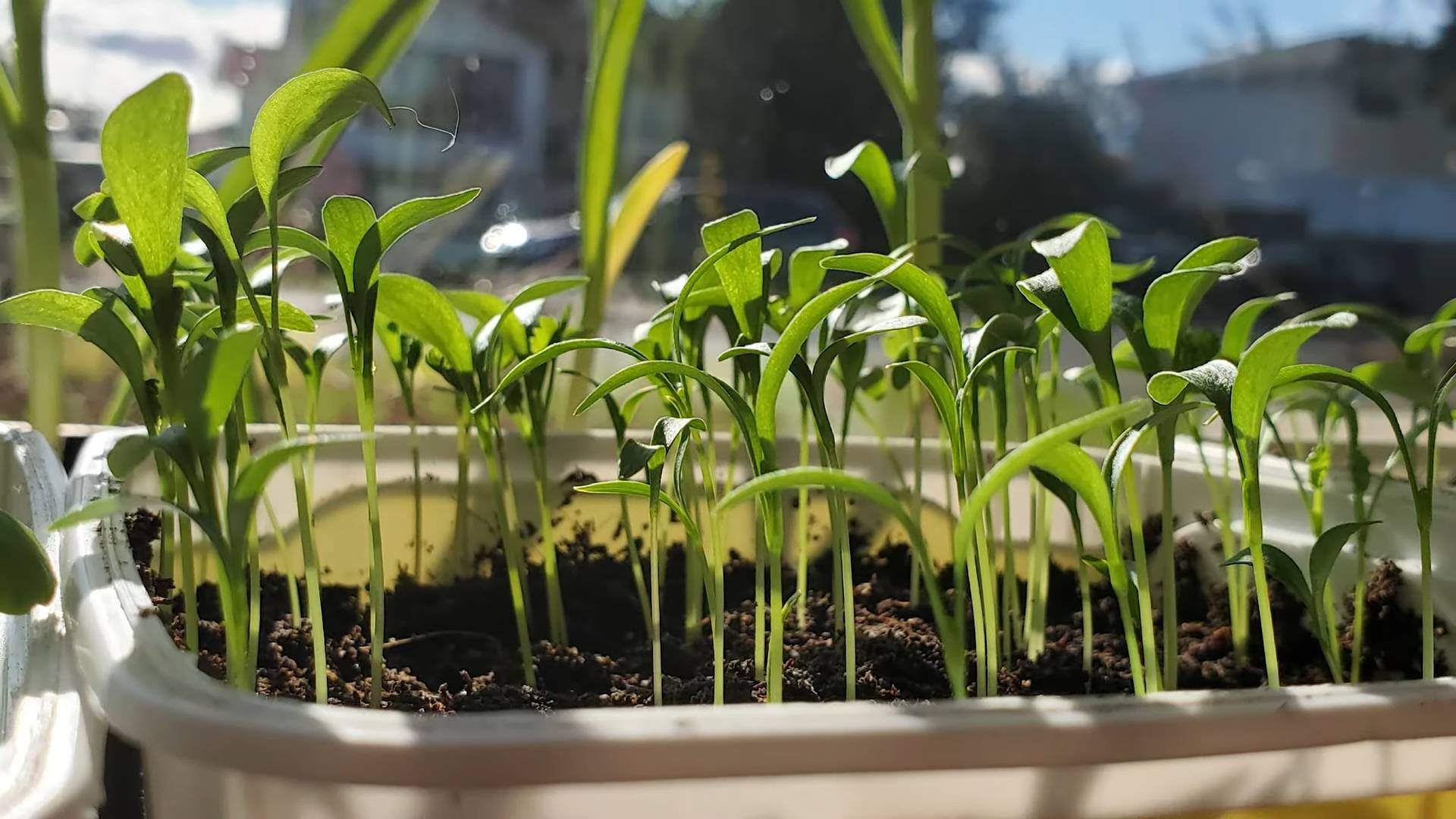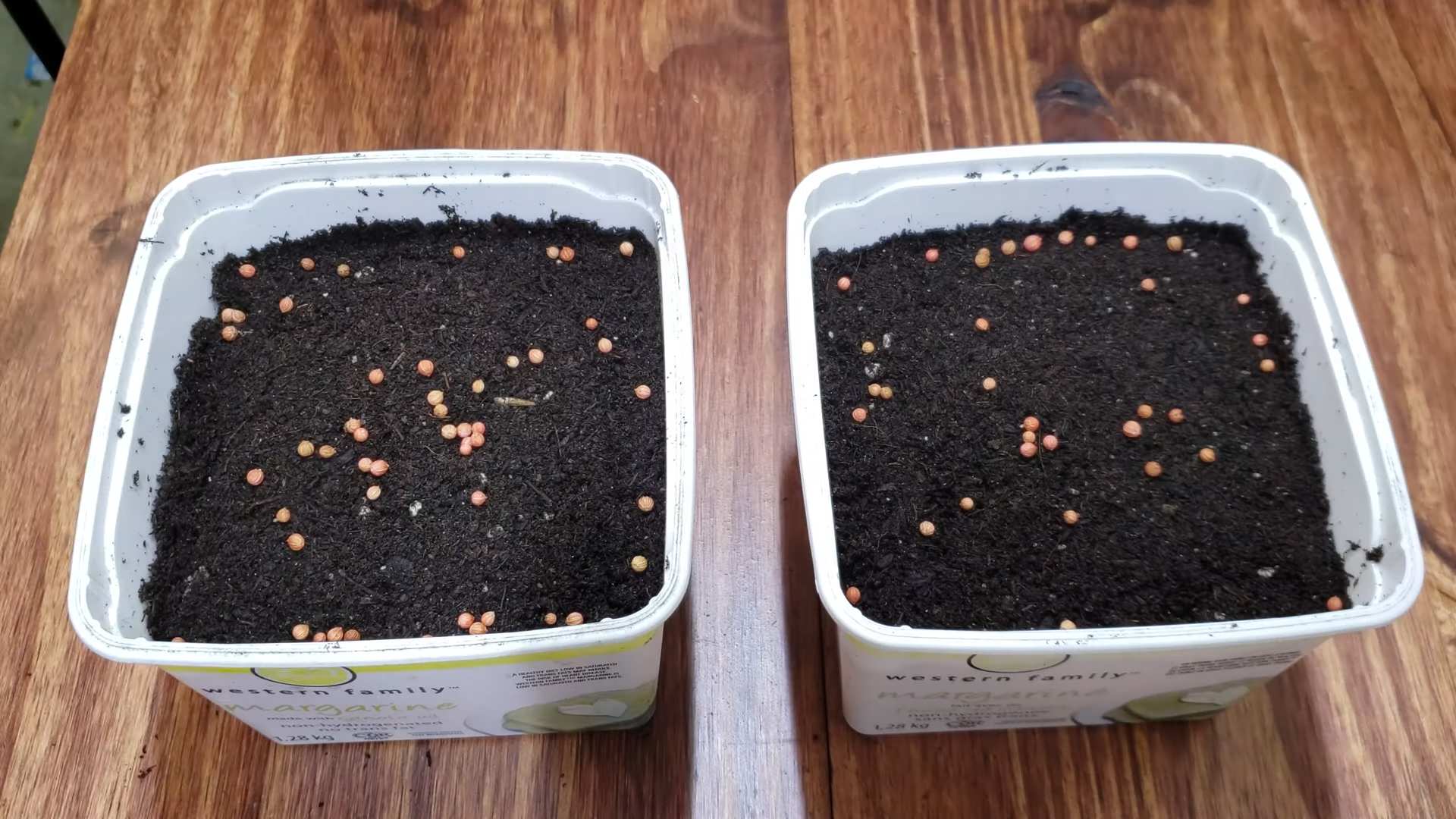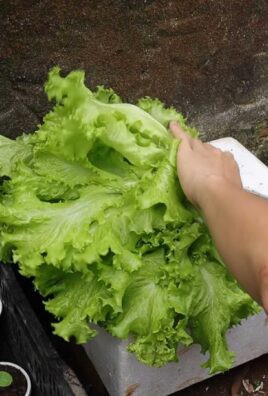Grow Cilantro Indoors? Absolutely! Imagine fresh, vibrant cilantro always at your fingertips, ready to elevate your tacos, salads, and salsas. No more sad, wilted bunches from the grocery store! For centuries, cilantro, also known as coriander in some parts of the world, has been a culinary staple, adding a bright, citrusy note to dishes across various cultures, from Mexican to Indian cuisine. But let’s face it, keeping cilantro fresh can be a real challenge.
That’s where this DIY guide comes in! I’m going to share my tried-and-true secrets for successfully grow cilantro indoors, regardless of your experience level. Whether you’re a seasoned gardener or a complete newbie, these simple tricks and hacks will empower you to cultivate your own thriving cilantro patch right in your kitchen. Think of the money you’ll save, the flavor you’ll enhance, and the satisfaction of harvesting your own fresh herbs.
Ready to ditch the grocery store cilantro and embrace the joy of homegrown flavor? Let’s get started!

Grow Your Own Cilantro Indoors: A Step-by-Step Guide
Hey there, fellow plant enthusiasts! Are you tired of buying cilantro at the grocery store only to have it wilt away in your fridge within days? I feel you! That’s why I decided to take matters into my own hands and learn how to grow my own cilantro indoors. Not only is it incredibly rewarding, but it also ensures I always have fresh, flavorful cilantro on hand for my favorite dishes. And trust me, it’s easier than you think! Let me walk you through the process.
Choosing the Right Cilantro Variety
Before we dive into the nitty-gritty, let’s talk about cilantro varieties. While most cilantro varieties will grow indoors, some are better suited than others.
* Slow-Bolting Varieties: These are your best bet. Bolting is when the plant prematurely goes to seed, which makes the leaves bitter. Slow-bolting varieties are bred to resist this, giving you a longer harvest. Look for names like ‘Slow Bolt,’ ‘Long Standing,’ or ‘Santo.’
* Consider Your Space: If you’re limited on space, a compact variety might be a good choice.
Gathering Your Supplies
Okay, now for the fun part – gathering our supplies! Here’s what you’ll need to get started:
* Cilantro Seeds: You can find these at most garden centers or online. Make sure they are fresh for the best germination rate.
* Potting Mix: Use a well-draining potting mix specifically formulated for containers. Avoid using garden soil, as it can compact and hinder drainage.
* Container: Choose a pot that’s at least 6 inches deep and wide. Cilantro has a taproot, so it needs room to grow. Make sure the pot has drainage holes!
* Grow Lights (Optional but Recommended): While cilantro can grow near a sunny window, grow lights will provide consistent and adequate light, especially during the winter months.
* Watering Can or Spray Bottle: For gentle watering.
* Small Shovel or Trowel: For planting the seeds.
* Seed Starting Tray (Optional): If you prefer to start your seeds indoors before transplanting.
Planting Your Cilantro Seeds
Alright, let’s get our hands dirty! Here’s how to plant your cilantro seeds:
1. Prepare the Pot: Fill your chosen container with potting mix, leaving about an inch of space at the top. Gently pat down the soil to remove any large air pockets.
2. Sow the Seeds: Cilantro seeds have a hard outer shell, so I like to scarify them slightly to improve germination. You can do this by gently rubbing the seeds between two pieces of sandpaper or by lightly crushing them with a rolling pin. Don’t overdo it, though!
3. Space the Seeds: Sprinkle the seeds evenly over the surface of the soil. You can plant them fairly close together, about ½ inch apart.
4. Cover the Seeds: Lightly cover the seeds with about ¼ inch of potting mix.
5. Water Gently: Use a watering can or spray bottle to gently moisten the soil. Avoid overwatering, as this can cause the seeds to rot.
6. Provide Warmth: Cilantro seeds germinate best in warm temperatures (around 65-70°F). You can place the pot on a heat mat or in a warm location to speed up germination.
7. Cover with Plastic Wrap (Optional): To help retain moisture, you can cover the pot with plastic wrap. Remove the plastic wrap once the seedlings emerge.
Caring for Your Cilantro Seedlings
Once your cilantro seedlings emerge (usually within 7-14 days), it’s time to provide them with the care they need to thrive.
1. Provide Adequate Light: Cilantro needs at least 6 hours of sunlight per day. If you don’t have a sunny window, use grow lights to supplement the natural light. Place the grow lights a few inches above the seedlings.
2. Water Regularly: Keep the soil consistently moist, but not soggy. Water when the top inch of soil feels dry to the touch. Avoid overwatering, as this can lead to root rot.
3. Fertilize Sparingly: Cilantro doesn’t need a lot of fertilizer. You can feed it with a diluted liquid fertilizer every few weeks. I like to use a balanced fertilizer (e.g., 10-10-10) diluted to half strength.
4. Thin the Seedlings: Once the seedlings are a few inches tall, thin them out so that they are about 2-3 inches apart. This will give them enough room to grow and prevent overcrowding. You can snip the extra seedlings at the base with scissors.
5. Pinch Off Flower Buds: As your cilantro plant matures, it may start to produce flower buds. Pinch these off to encourage the plant to produce more leaves. Once the plant starts to bolt (go to seed), the leaves will become bitter.
Harvesting Your Cilantro
The best part! You can start harvesting your cilantro leaves when the plants are about 6-8 inches tall.
1. Harvest Regularly: Regular harvesting will encourage the plant to produce more leaves.
2. Cut the Stems: Use scissors or pruning shears to cut the stems about an inch above the soil line.
3. Harvest from the Outside: Focus on harvesting the outer leaves first, allowing the inner leaves to continue growing.
4. Enjoy Your Fresh Cilantro: Use your freshly harvested cilantro in your favorite dishes! It’s delicious in salsas, guacamole, tacos, soups, and salads.
Troubleshooting Common Problems
Even with the best care, you might encounter some problems while growing cilantro indoors. Here are a few common issues and how to address them:
* Yellowing Leaves: This could be a sign of overwatering, underwatering, or nutrient deficiency. Check the soil moisture and adjust your watering accordingly. If the soil is dry, water thoroughly. If the soil is soggy, allow it to dry out before watering again. You can also try fertilizing with a diluted liquid fertilizer.
* Leggy Growth: This is usually caused by insufficient light. Move your cilantro plant to a sunnier location or use grow lights to supplement the natural light.
* Bolting: As mentioned earlier, bolting is when the plant prematurely goes to seed. This is often caused by hot temperatures or stress. To prevent bolting, keep your cilantro plant in a cool location and water it regularly. Pinch off any flower buds as soon as you see them.
* Pests: Cilantro can be susceptible to pests like aphids and spider mites. Inspect your plants regularly for signs of infestation. If you find pests, you can try spraying them with insecticidal soap or neem oil.
Extending Your Cilantro Harvest
Want to keep the cilantro coming? Here are a few tips to extend your harvest:
* Succession Planting: Plant new seeds every few weeks to ensure a continuous supply of cilantro.
* Cool Temperatures: Cilantro prefers cool temperatures (60-70°F). If you live in a warm climate, try growing your cilantro in a cooler location or during the cooler months.
* Harvest Regularly: As mentioned earlier, regular harvesting will encourage the plant to produce more leaves.
* Save the Seeds: If your cilantro plant does bolt, you can save the seeds for future planting. Allow the seed pods to dry on the plant, then harvest them and store them in a cool, dry place.
Bonus Tip: Growing Cilantro from Cuttings
Did you know you can also propagate cilantro from cuttings? It’s a great way to clone your favorite cilantro plant!
1. Take a Cutting: Choose a healthy stem that’s about 4-6 inches long. Cut the stem just below a node (the point where leaves grow).
2. Remove Lower Leaves: Remove the lower leaves from the cutting, leaving only a few leaves at the top.
3. Rooting Hormone (Optional): Dip the cut end of the stem in rooting hormone to encourage root growth.
4. Place in Water: Place the cutting in a glass of water, making sure that the leaves are above the water line.
5. Wait for Roots: Place the glass in a bright, indirect light location. Change the water every few days. Roots should start to form within a week or two.
6. Plant in Soil: Once the roots are about an inch long, you can plant the cutting in a pot filled with potting mix.
7. Care for the New Plant: Care for the new plant as you would any other cilantro plant.
Final Thoughts
Growing cilantro indoors is a rewarding and easy way to have fresh herbs on hand whenever you need them. With a little bit of care and attention, you can enjoy a continuous supply of flavorful cilantro for your favorite dishes. So, grab your seeds, potting mix,

Conclusion
So, there you have it! Growing cilantro indoors is not only achievable, but it’s also a game-changer for anyone who loves fresh herbs at their fingertips. Forget those sad, wilted bunches from the grocery store that seem to expire the moment you get them home. With a little effort and the right setup, you can have a constant supply of vibrant, flavorful cilantro ready to elevate your culinary creations.
Why is this DIY trick a must-try? Because it empowers you to control the quality and freshness of your cilantro. You know exactly where it came from, what it’s been exposed to, and how it’s been cared for. This translates to a superior taste and aroma that store-bought cilantro simply can’t match. Plus, it’s incredibly satisfying to nurture a plant from seed to harvest, knowing you’ve created something delicious with your own two hands.
Beyond the basic method, there are plenty of ways to customize your indoor cilantro garden. Consider experimenting with different varieties of cilantro, such as ‘Santo’ or ‘Slow Bolt,’ which are known for their slower bolting tendencies (meaning they’re less likely to go to seed quickly). You can also try companion planting, placing your cilantro near other herbs or vegetables that benefit from its presence, such as basil or tomatoes. Another variation is to use a self-watering planter to minimize the risk of over or under-watering, especially if you’re a forgetful gardener. You can also explore hydroponic systems for growing cilantro indoors, which can lead to faster growth and higher yields.
Don’t be intimidated if you’ve never grown herbs indoors before. Cilantro is a relatively forgiving plant, and even if you encounter a few challenges along the way, the reward of fresh, homegrown cilantro is well worth the effort. Remember to provide adequate light, well-draining soil, and consistent moisture, and you’ll be well on your way to a thriving indoor cilantro garden.
We wholeheartedly encourage you to give this DIY trick a try. Imagine the possibilities: freshly made salsa with cilantro you grew yourself, vibrant garnishes for your favorite tacos, or a burst of flavor in your Asian-inspired dishes. The possibilities are endless!
Once you’ve embarked on your indoor cilantro growing journey, we’d love to hear about your experience. Share your tips, tricks, and triumphs in the comments below. Let’s create a community of indoor herb enthusiasts and inspire others to discover the joy of growing their own fresh ingredients. Did you find a particular grow light that works wonders? Did you discover a secret to preventing bolting? Share your wisdom! Your insights could be invaluable to someone just starting out. Let’s all learn together how to best grow cilantro indoors.
Frequently Asked Questions (FAQ)
1. What kind of soil is best for growing cilantro indoors?
The ideal soil for growing cilantro indoors is a well-draining potting mix. Avoid using garden soil, as it tends to be too heavy and can compact easily, hindering root growth and potentially leading to root rot. Look for a potting mix specifically formulated for herbs or vegetables, or create your own by combining equal parts of potting soil, perlite, and vermiculite. This combination provides good drainage, aeration, and moisture retention, all of which are essential for healthy cilantro growth. The perlite and vermiculite help to prevent the soil from becoming waterlogged, which is a common problem when growing plants indoors.
2. How much sunlight does indoor cilantro need?
Cilantro thrives in bright, indirect sunlight. Ideally, it needs at least 6-8 hours of sunlight per day. If you don’t have a sunny windowsill, you can supplement with a grow light. Place the grow light about 6-12 inches above the plants and keep it on for 12-14 hours per day. Without sufficient light, your cilantro will become leggy and weak, and it may not produce as much foliage. Rotate your cilantro plants regularly to ensure that all sides receive equal exposure to light. If you notice the leaves turning yellow or pale, it’s a sign that the plant is not getting enough light.
3. How often should I water my indoor cilantro?
Water your cilantro regularly, keeping the soil consistently moist but not waterlogged. Check the soil moisture by sticking your finger about an inch into the soil. If it feels dry, it’s time to water. Water deeply, allowing the excess water to drain out of the bottom of the pot. Avoid overwatering, as this can lead to root rot. During the warmer months, you may need to water more frequently than during the cooler months. Also, consider the type of pot you’re using. Terracotta pots tend to dry out faster than plastic pots.
4. Why is my cilantro bolting (going to seed)?
Bolting is a common problem with cilantro, especially in warm weather. It’s a natural process where the plant focuses on producing seeds rather than foliage. To prevent bolting, try to keep the temperature around your cilantro plants cool (below 75°F). You can also choose bolt-resistant varieties of cilantro, such as ‘Santo’ or ‘Slow Bolt.’ Regularly harvest the leaves to encourage the plant to produce more foliage. If your cilantro does start to bolt, you can still use the leaves, but they may have a slightly bitter taste. You can also harvest the seeds (coriander) for use in cooking.
5. How do I harvest cilantro leaves?
Harvest cilantro leaves by snipping them off with scissors or pinching them off with your fingers. Start harvesting when the plants are about 6 inches tall. Harvest the outer leaves first, leaving the inner leaves to continue growing. Regular harvesting will encourage the plant to produce more foliage and prevent it from bolting. Avoid harvesting more than one-third of the plant at a time, as this can stress the plant.
6. Can I grow cilantro from seed indoors?
Yes, you can easily grow cilantro from seed indoors. Sow the seeds directly into your potting mix, about ¼ inch deep. Keep the soil moist and warm (around 70°F) until the seeds germinate, which usually takes about 7-10 days. Once the seedlings emerge, thin them out so that they are spaced about 2-3 inches apart. You can also start cilantro seeds in seed trays or peat pots and transplant them into larger pots once they have developed a few sets of true leaves.
7. What are some common pests and diseases that affect indoor cilantro?
Common pests that can affect indoor cilantro include aphids, spider mites, and whiteflies. These pests can be controlled with insecticidal soap or neem oil. Diseases that can affect indoor cilantro include powdery mildew and root rot. Powdery mildew can be prevented by providing good air circulation and avoiding overhead watering. Root rot can be prevented by using well-draining soil and avoiding overwatering. Regularly inspect your plants for signs of pests or diseases and take action promptly to prevent them from spreading.
8. How long will my indoor cilantro plant last?
Cilantro is an annual plant, meaning it completes its life cycle in one growing season. However, with proper care, you can extend the life of your indoor cilantro plant for several months. To prolong its life, keep the temperature cool, provide adequate light, and regularly harvest the leaves. Once the plant starts to bolt, it will eventually die. However, you can collect the seeds and sow them to start new plants.
9. Can I transplant store-bought cilantro into a pot to grow indoors?
While it’s possible to transplant store-bought cilantro, it’s generally not recommended. Store-bought cilantro is often grown in less-than-ideal conditions and may not have a strong root system. It’s also possible that the cilantro has been treated with chemicals that could inhibit its growth. It’s best to start with fresh seeds to ensure healthy and vigorous growth. However, if you do want to try transplanting store-bought cilantro, choose a healthy-looking bunch with strong roots. Gently separate the plants and plant them in well-draining potting mix. Keep the soil moist and provide adequate light.
10. Is it possible to grow cilantro indoors year-round?
Yes, it is absolutely possible to grow cilantro indoors year-round, provided you can replicate the optimal growing conditions. This means ensuring adequate light, temperature control, and proper watering. Using a grow light is crucial during the winter months when natural sunlight is limited. By carefully managing these factors, you can enjoy a continuous supply of fresh cilantro, regardless of the season.





Leave a Comment